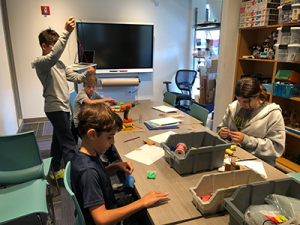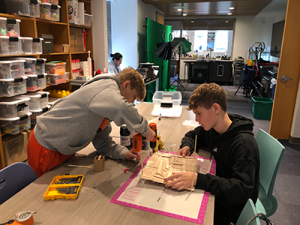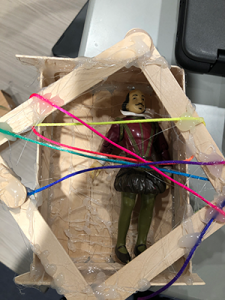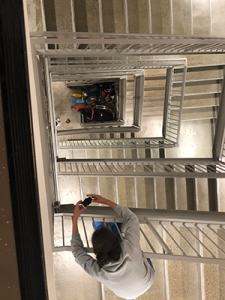 The new Blue Cluster STEAM Fine Arts course is wrapping up their first major Design Cycle/Open Ended Problem Solving Project. The course, introduced this school year, combines STEAM (Science, Technology, Engineering, Arts, and Math) practices with fine arts to create hands-on projects in which the students learn how the five different aspects fit together to develop a final product. Technology instructor Brian Russ was inspired to create this particular project from his desire to use the South Building stairwell, and the incredible story of the rescue of the soccer team who got stuck in a cave in Thailand in 2018.
The new Blue Cluster STEAM Fine Arts course is wrapping up their first major Design Cycle/Open Ended Problem Solving Project. The course, introduced this school year, combines STEAM (Science, Technology, Engineering, Arts, and Math) practices with fine arts to create hands-on projects in which the students learn how the five different aspects fit together to develop a final product. Technology instructor Brian Russ was inspired to create this particular project from his desire to use the South Building stairwell, and the incredible story of the rescue of the soccer team who got stuck in a cave in Thailand in 2018.
Students faced three main challenges:
- Figure out exactly how deep the stairwell is from the ground of the first floor South lobby to the 5th floor landing,
- Build a way of getting supplies to a theoretically “trapped” Shakespeare figurine without being able to descend any of the stairs themselves,
- Build a contraption for safely rescuing Shakespeare.
In order to determine the depth of the stairwell, students used different methods including the iPhone’s “Measure” tool, a measuring tape, and lengths of ribbon and string. For each group, the students sent down a “camera” (which was really another student with a laptop) that would report to them.
Once they had determined the depth of the stairwell, the students needed to figure out how they could get supplies down to the Shakespeare figurine. The students built supply baskets out of cardboard that they could lower down to the bottom of the stairwell, as well as made “supplies” such as food, first aid kits, and water out of Model Magic clay to send down in the basket. The students worked to build their basket so it could hold the supplies without them falling out, which acted as a “trial run” to see how they could improve their design so it would be successful in saving Shakespeare.
Finally, using what they learned from measuring the depth of the stairwell and getting supplies down to Shakespeare, the students worked on creating a device that would successfully rescue the figurine from the bottom of the stairwell. Their final designs were built out of popsicle sticks, and needed to be able to bring Shakespeare up without him falling out. Mr. Russ gave the students free reign on what their designs would look like, so they could utilize their creativity to create unique designs for each team.  The students then had a friendly competition to see who could deliver food and supplies and rescue Shakespeare from imminent peril the fastest. Times ranged from 9 minutes to 44 seconds!
The students then had a friendly competition to see who could deliver food and supplies and rescue Shakespeare from imminent peril the fastest. Times ranged from 9 minutes to 44 seconds!
This project was not only hands-on, but even got their whole bodies involved, as some teams discovered the fastest way to get Shakespeare up the stairwell was for one student to hold the end of the string connected to their device and spin around, so that the string wound around their body. The winning team used this method!
 Now that all the teams have successfully rescued Shakespeare, the students will finalize the project by critiquing each other’s builds and designs in a reflection/share out. The measurement of the stairwell demonstrated the math aspect of STEAM, the creation of the devices for supplies and rescue demonstrated the science, engineering, and technology aspects, and the creativity put into the device’s designs and the clay supplies demonstrated the art aspect.
Now that all the teams have successfully rescued Shakespeare, the students will finalize the project by critiquing each other’s builds and designs in a reflection/share out. The measurement of the stairwell demonstrated the math aspect of STEAM, the creation of the devices for supplies and rescue demonstrated the science, engineering, and technology aspects, and the creativity put into the device’s designs and the clay supplies demonstrated the art aspect.
The students were so incredibly enthusiastic about the project that word spread to the rest of the Gaynor community about how cool it was.The next project that the students are moving on to is building and designing catapults, keeping with the Shakespearian/medieval theme.

